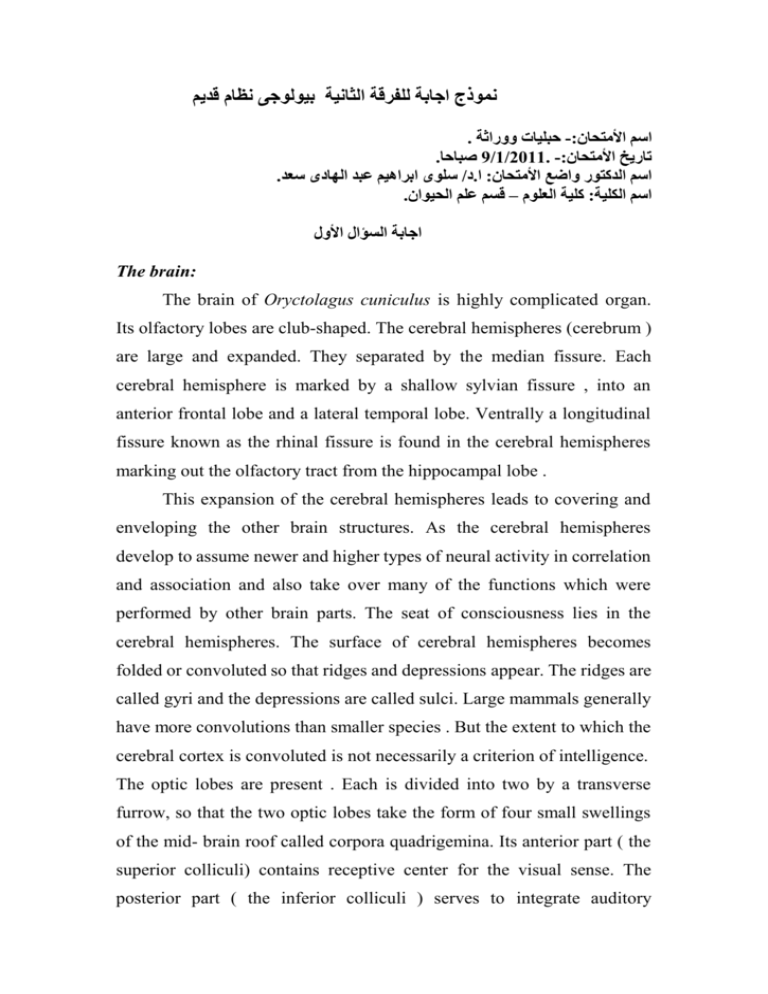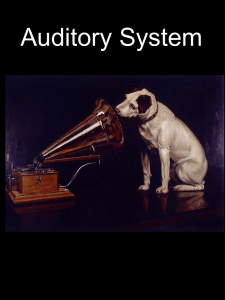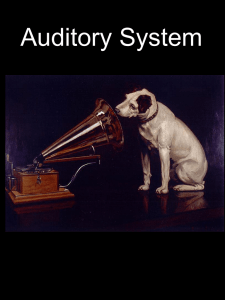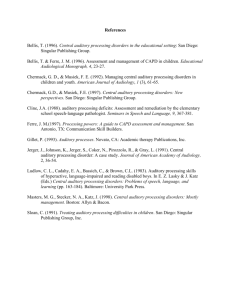نموذج
advertisement

نموذج اجابة للفرقة الثانية بيولوجى نظام قديم . حبليات ووراثة-:اسم األمتحان . صباحا9/1/2011. -:تاريخ األمتحان . سلوى ابراهيم عبد الهادى سعد/د. ا:اسم الدكتور واضع األمتحان . كلية العلوم – قسم علم الحيوان:اسم الكلية اجابة السؤال األول The brain: The brain of Oryctolagus cuniculus is highly complicated organ. Its olfactory lobes are club-shaped. The cerebral hemispheres (cerebrum ) are large and expanded. They separated by the median fissure. Each cerebral hemisphere is marked by a shallow sylvian fissure , into an anterior frontal lobe and a lateral temporal lobe. Ventrally a longitudinal fissure known as the rhinal fissure is found in the cerebral hemispheres marking out the olfactory tract from the hippocampal lobe . This expansion of the cerebral hemispheres leads to covering and enveloping the other brain structures. As the cerebral hemispheres develop to assume newer and higher types of neural activity in correlation and association and also take over many of the functions which were performed by other brain parts. The seat of consciousness lies in the cerebral hemispheres. The surface of cerebral hemispheres becomes folded or convoluted so that ridges and depressions appear. The ridges are called gyri and the depressions are called sulci. Large mammals generally have more convolutions than smaller species . But the extent to which the cerebral cortex is convoluted is not necessarily a criterion of intelligence. The optic lobes are present . Each is divided into two by a transverse furrow, so that the two optic lobes take the form of four small swellings of the mid- brain roof called corpora quadrigemina. Its anterior part ( the superior colliculi) contains receptive center for the visual sense. The posterior part ( the inferior colliculi ) serves to integrate auditory impulses . Most of the mid-brain functions have been transferred to the grey matter of the cerebral hemispheres. Thus, most of the sensory stimuli which are integrated in the mid-brain in lower vertebrates are , instead, projected to the hemispheres. Most auditory and other somatic sensations which reach the mid-brain are, in mammals, relayed onward to the hemispheres. It is especially notable that few of the optic fibers in mammals follow the original course to the mid-brain; most are interrupted and visual stimuli are transferred forward to the hemispheres. The cerebellum is very large , folded and consists of a median lobe ( the vermis ) and two lateral lobes. Each lateral lobe carries externally a small lobe (the flocculus) . The vermis is divided into anterior, middle and posterior lobes. The surface of the cerebellum is thrown into numerous folds or gyri, separated by sulci. On the ventral side is found a conspicuous pons Varolii which is composed of a prominent mass of transverse nerve fibers. The function of the cerebellum is to coordinate the neuromuscular mechanism of the body. The cerebellum is much more highly developed in animals that are active , whether such activity occurs in water, on land , or in the air . It is large in many fishes, birds and Mammals , small in reptiles, little developed in cyclostomes and amphibians. The medulla oblongata is well - developed, merging backwards into the spinal cord. The crus cerebrum is a large band of fibers on each side and lying infront of the pons Varolii and connects the medulla with the hemispheres. The auditory organ A true external ear which catches and directs sound waves into the, auditory canal is found only in mammals. It is called the pinna or auricle. Wax glands , as well as protective hairs, are integumentary derivatives found in the auditory canal ( external auditory meatus ) . The tympanic membrane is situated at the end of this canal. The middle ear is surrounded by a bony tympanic bulla which is part of the temporal bone . The Eustachian tubes open separately . Instead of a single auditory bone (the columella auris ), the mammalian middle ear contains an articulated chain of three auditory ossicles leading from ear drum to the fenestra ovalis; malleus , incus and stapes. The latter is much reduced and it is equivalent to the whole columellar apparatus. The malleus derived from the articular bone of lower forms. It connects at one end with the tympanic membrane and with the incus on the other . The incus , which is homologous with the quadrate bone of lower vertebrate, lies between the malleus and stapes. The three auditory ossicles serve to transmit sound vibrations from tympanic membrane to the membrane of the fenestra ovalis . The equilibratory portion of the inner ear remains relatively unchanged from reptiles to mammals, hi Amniota the lagena is lengthened to form the cochlear duct, and the sensory basilar papilla is elaborated into the organ of Corti, which is the actual receptor organ for the sense of hearing . The cochlear duct begins to assume a spiral form in crocodiles and birds . In mammalian the spiral becomes more complicated . Thus the cochlea is divided into three longitudinal spaces or chambers called the scalae. The upper one is the scala vestibuli, and the lower is the scala tympani. These are filled with fluid perilymph. Between the two is the scala media or cochlear duct. Like other parts of the labyrinth , it is filled with endolymph . The three scalae together make up the cochlea. The floor of the scala media is called the basilar membrane. This separates the endolymph in the scala from the perilymph in the scala tympani . The thin, sloping roof of the scala media is referred to as the vestibular, or Reissner's membrane . It separates the endolymph in the scala media from the perilymph in the scala vestibuli. At the apex of the cochlea the scala vestibuli is continuous with the scala tympani . The point of junction is the helicotrema. The scala media ends blindly at the helicotrema. The basilar membrane supports the organ of Corti. The latter is composed of numerous hair - like cells which have connections at their bases with fibers of the auditory nerve. اجابة السؤال الثانى For the first time a completely double circulation occurs in birds where there is no point of mixing of oxygenated and unoxygenated blood. The circulatory system of Columba livia consists of heart, arterial and venous systems. The heart The sinus venosus of the heart has disappeared. There are two auricles and two ventricles. Generally, in birds, the heart is relatively much larger and more compact than in previous forms. The wall of auricles is thin . The ventricles are completely separated and the muscular wall of the left ventricle being much heavier than the right one . There is a single valve which separates right auricle from right ventricle . Also there are two valves ( bicupsid valve ) between the left auricle and the left ventricle. The right auricle receives two precavals and one postcaval. The left auricle receives four pulmonary veins which return oxygenated blood from the lungs . The right ventricle gives one pulmonary artery which divides after a short distance into right and left pulmonary arteries each goes to one of the lungs. The left ventricle gives rise to one big vessel (right aortic arch) carrying the pure blood to various parts of the body . The left aortic arch is eliminated in birds. Arterial system : The single aortic arch which carries the pure blood and which arises from the left ventricle extends a short distance anteriorly giving rise to two innominate arteries; right and left ones then it curves to the right side and posteriorly where it extends as the median dorsal aorta . Each one of the two innominates gives a common carotid artery to the head region , a subclavian artery to the wing and a pectoral artery to the pectoralis muscle. The dorsal aorta extends in the mid-dorsal line giving to the alimentary canal three single vessels; coeliac artery, anterior mesenteric and posterior mesenteric . It gives to the kidneys a pair of first renal arteries, then gives the paired femorals and sciatics to the hind limb. From each sciatic arises the second and third renal arteries. Then it gives the paired iliacs to the pelvic region and it ends by a very short caudal artery . Venous system : The right auricle receives the two precavals and the postcaval. Each precaval is made by the jugular vein coming from the head region, the brachial vein coming from the wing and pectoral vein coming from the pectoralis muscles. The two jugulars are connected together by a transverse duct (interjugular connection). A small caudal vein is joined by a large coccygeomesenteric vein coming from the posterior part of the alimentary canal and it divides into two renal portal veins . These veins pass undivided inside the tissues of the kidneys and so there is no renal portal circulation . Each renal portal vein receives a small internal iliac, a small sciatic ,and then a large femoral vein , after which it becomes a large iliac vein . The two iliacs unite together into the postcaval which receives in its way to the heart a number of hepatic veins . The hepatic portal circulation is present. اجابة السؤال الثالث The digestive system of Petromyzon fluviatilis starts with a small mouth opening above the tongue and leads into a large buccal cavity . This cavity leads posteriorly into a dorsal passage, ( esophagus ) for the food and a ventral respiratory tube , which leads to the gill pouches. The valve - like velum lies at the entrance to the respiratory tube. The esophagus leads into a stomach . The latter consists of an enlargement at the posterior end of the esophagus . The stomach leads to a straight tube ( intestine). At its posterior end it enlarges slightly to form a rectum which terminates in an anus . Inside the intestine there is a fold known as the typhlosole or spiral valve. A large bilobed liver is present but in the adult there is no gall bladder or bile duct. The three structures are present in Ammocoetes larva of Petromyzon . The pancreas is absent and instead of it there is a large patches of cells , in the wall of the anterior part of intestine, that resemble those of the acini of the pancreas of higher vertebrates. The spleen is absent. The salivary glands are present as a pair of pigmented sacs, embedded in the hypobranchial muscles. Each has a duct while opens below the tongue. The salivary glands secrete an anticoagulant ( lamphedrin ) to facilitate the flow of blood from an animal attacked , by the lamprey . The digestive system of Tilapia nilotica begins with mouth opening which leads to the wide pharynx. The side walls of pharynx are perforated by five vertical gill slits. The gills are fringed by teeth-like structures (the gill rackers). The pharynx leads by means of a short esophagus into the stomach. The stomach is characterized by possessing a large posteriorly closed caecum. There is no spiral valve in the intestine and instead of it is much coiled and is composed of duodenum, ileum and rectum. There are no sharp lines of demarcation between these parts. There is no rectal gland, no cloaca and the rectum opens to the exterior by a distinct anus. The liver is large, bilobed, but the left lobe is larger than the right and extends nearly as far backwards as the posterior wall of the body cavity. The gallbladder is large and spherical. A bile duct extends from it to open into the anterior end of the intestine. The pancreas is diffused inside the liver and part of it is found as patches of whitish tissue near the anterior end of the intestine. The spleen lies between the caecal portion of the stomach and the left lobe of the liver. اجابة السؤال الرابع The component of axial endoskeleton of Sclyiorhinus canicula is formed of cartilage and it is composed of skull, vertebral column and ribs. The skull ( chondrocranium ) : It consists of the cranium , sense capsules (neurocranium) and visceral arches ( viscerocranium ) . The cranium is an elongated box surrounding the brain . Its roof possesses a large opening ( anterior fontanelle ), The cranium is fused anteriorly with the two olfactory capsules and posteriorly with the two auditory capsules. Between the olfactory and auditory capsules are found two large depressions one on each side ( the orbit) inside which the eyes are located . The foramen magnum is found at the posterior end of the cranium . There are two occipital condyles, on the two sides of the foramen magnum , that articulate with the first vertebra . The brain case is perforated by several foramina for the passage of the cranial nerves and blood vessels. The visceral arches are seven in number. They surrounded and protect the pharynx. The first arch is called the mandibular arch ; the second one is known as the hyoid arch and the last five are known as the branchial arches. The mandibular arch consists of four piece of cartilage; two dorsal (the palatoquadrates ) meet each other anteriorly and form the upper jaw and two ventral ones (Meckel's cartilage ) are fused together anteriorly to form the lower jaw. The second visceral arch is formed of five piece of cartilage; two hyomandibulars, two ceratohyals and one basihyal in the floor of the mouth . Each one of branchial arches consists typically of four piece of cartilages on either side as the following :1- The pharyngobranchial is found in the roof of the pharynx, the last two of them are united together. 2- The epibranchial in the dorso-lateral wall of the pharynx. 3- The ceratobranchial in the ventro-lateral wall of the pharynx. 4- The hyobranchial in the ventral wall of the pharynx. There is no hyobranchial for the last branchial arch . The last two pairs of hyobranchials and the fifth ceratobranchials join a median basibranchial plate. The epibranchial and ceratobranchial carry a number of rays ( branchial rays ) . These rays are found on all the branchial arches except the last. The upper and lower jaws carry several rows of teeth. Jaw suspension : The nature of the hyomandibular serves to introduce the general problem of the suspension of the jaws on the skull in fishes. In dogfish , each hyomandibular possesses a dorsal head fixed to the auditory capsule and a ventral one which is connected by ligament to both the palatoquadrate and Meckel's cartilage of its side. Thus, the upper and ;lower jaws have no direct connection with the brain case and the jaw joint is carried out through the hyomandibular cartilage . This type of jaw suspension is called hyostylic . In a few sharks there is support both from the hyomandibular and from a direct articulation of upper jaw and brain case ( an amphistylic condition ) . In other fishes the hyomandibular is non -functional as a supporting structure and the upper jaw region is entirely responsible for its own suspension ( autostylic). Land vertebrates are all autostylic . Vertebral column : It is divided into two distinct regions : 1- The trunk region is composed of the trunk vertebrae 2- The tail region is composed of the caudal vertebrae . The trunk vertebra bears a biconcave (amphicoelous ) centrum through its center the compressed notochord (notochord rudiment) runs . The notochord is not constricted between the centra of the successive vertebrae. The centrum is formed by the invasion of the notochordal sheath by cartilage . Then the notochord gradually decreases in size until it disappears in the adult animal. Some mesodermal cells is appeared around the notochord to form a skeletogenous tissue which is more condensed at four places, two dorsal above the notochord and two ventral below it. These are two basidorsal and two basiventral respectively . The two basidorsals extend dorsally forming the neural arch enclosing the neural canal which includes the spinal cord, and carrying at its apex a dorsal process ( neural spine ) . In trunk region the basiventrals extend laterally forming the transverse process, but in the tail region they extend ventrally forming the haemal arch surrounding the caudal artery and vein, and carrying at its lower edge a ventral process ( haemal spine ) . Small ribs are attached to the transverse processes of the trunk vertebrae . نهاية اجابة األمتحان








